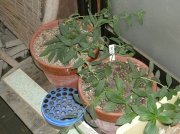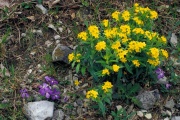Difference between revisions of "Gromwell root"
Jump to navigation
Jump to search
(username removed) |
(username removed) |
||
| Line 26: | Line 26: | ||
== Authority == | == Authority == | ||
| − | * ''Encyclopedia Britannica'', http://www.britannica.com Comment: "Boraginaceae." | + | * ''Encyclopedia Britannica'', http://www.britannica.com Comment: "Boraginaceae." Encyclopædia Britannica. 2004. Encyclopædia Britannica Premium Service. 30 Sept. 2004 . |
| − | * | + | * Website address 1 Comment: http://www.reconstructinghistory.com/japanese/dyes.html |
[[Category:Materials database]] | [[Category:Materials database]] | ||
Revision as of 07:22, 24 July 2013
Description
A natural dye extract from the roots of the perennial Lithospermum plants, most common of which are L. erythrorhizon (Japan and China) and L. officinale (North America). The red-purple root of the Gromwell plant is extracted with water to produce a non-lightfast purple colorant composed primarily of the nathaquinone compound shikonin. Called waka or usu in Japan, this purple color was restricted to the Imperial family.
See also puccoon.
Synonyms and Related Terms
murasaki (Jap.); shikonin; waka; usu; redroot; bloodroot ; Lithospermum erythrorhizon; Lithospermum officinale (stoneseed)
Hazards and Safety
Poor lightfastness
Additional Images
Authority
- Encyclopedia Britannica, http://www.britannica.com Comment: "Boraginaceae." Encyclopædia Britannica. 2004. Encyclopædia Britannica Premium Service. 30 Sept. 2004 .
- Website address 1 Comment: http://www.reconstructinghistory.com/japanese/dyes.html


